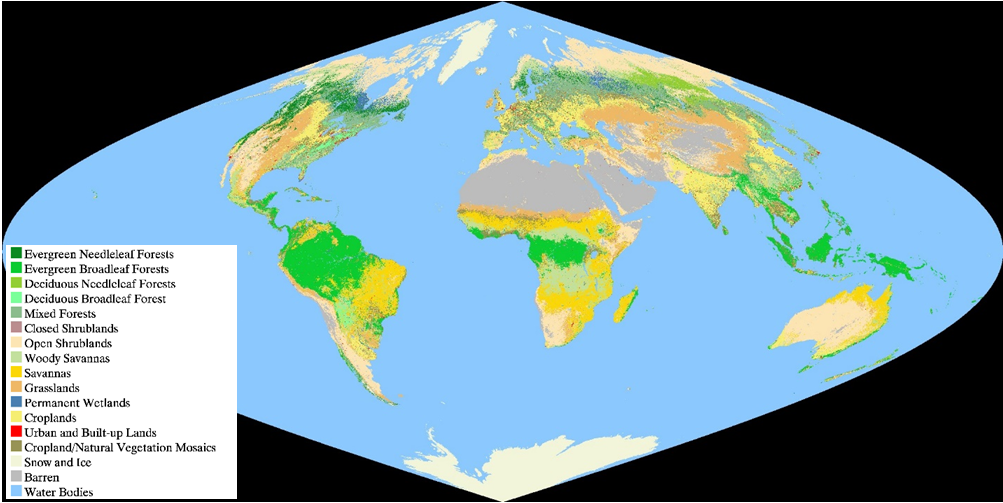Surface Type
Team Lead: Xiwu (Jerry) Zhan
- STAR JPSS VIIRS Surface Type ATBD, (PDF, 5.81 MB)
Background
The accurate description of actual terrestrial surface types from regional to global scales is essential information or input for many science and societal applications: land surface models for numerical weather, hydrological and ecological predictions, land and water resources management, implementation of national and international policies related to bio-diversity and climate change, and global change studies as input to climate and biogeochemical models.
Product History and Product Access
The previously referenced VIIRS Surface Type (ST) EDR from the S-NPP satellite was generated in IDPS as a granule product. It was based on a global gridded surface type map to label surface type of the pixels within each granule. The global gridded map was generated offline from IDPS. Since 2015, the JPSS program has dropped the granule ST EDR requirement, and the JPSS VIIRS Surface Type Team has been tasked to generate only the global gridded surface type map annually within NOAA NESDIS STAR. In February 2013, the ST EDR product reached beta maturity in IDPS. In July and December 2014, the product reached provisional and validated maturity, respectively. The most recent version of the global gridded Annual Surface Type Map is available from STAR JPSS VIIRS Surface Type FTP. For more information please contact Xiwu Zhan.
Products and data:
JSTAR Mapper Long Term-Monitoring
Documentation
- Surface Type ATBD, (PDF, 5.81 MB)
Users
Earth System Modelers: Land surface parameterization for GCMs (e.g.: Global Forecast System (GFS) and North America Mesoscale (NAM) Model of NWS-NCEP-EMC; Goddard Earth Observing Model (GEOS) system of NASA; The Weather Research and Forecasting (WRF) Model and Community Earth System Model (CESM) of National Center for Atmospheric Research (NCAR)) and for Hydrological processes (e.g., the Community Hydrologic Prediction System CHPS of NWS Office of Hydrological Development)
Carbon and ecosystem studies: Carbon stock, fluxes, biodiversity
Validation
The objective of ST validation is to ensure the overall classification accuracy of intermediate product aka global land cover map to meet the level 1 product requirement. The initial validation was performed using visual comparisons against high resolution images from satellite such as LandSat or Google map. The validation results suggested the VIIRS AST product is compatible with the heritage MODIS land cover product, and the classification accuracy is very similar to that of MODIS land cover. A recent validation was conducted by the University of Maryland team for the validated 1 stage maturity review. The validation results concluded that 73.92% of classification accuracy was obtained in the VIIRS AST product, which exceeded the required 70% threshold in JPSS level 1 requirement document (L1RD). More details about the recent validation efforts could be found in our annual reports to the STAR-JPSS annual science team meetings.
Ongoing improvements
The Surface Type team is tasked to generate the Global Surface Type Map annually so that the Surface Type product can describe certain changes of the land surface using the most recent VIIRS observations. New improvements for the global surface type map, including new support vector machine based classification algorithm, new training samples, and new annual classification metrics, will be implemented for all new deliveries/postings. Short term surface type changes such as flooded areas, burned areas and deforested areas as well as the active fire and snow covered areas are to be mapped in a new Daily Surface Type product which will be generated when manpower supports become available. More comprehensive validation of the Global Surface Type Map will be continuously conducted.

